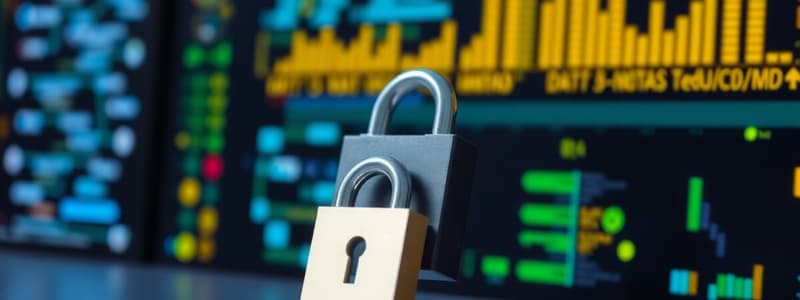Podcast
Questions and Answers
What is a key principle to follow in access management?
What is a key principle to follow in access management?
- Shared access privileges for all employees
- Open access policies for improved efficiency
- Least privilege access (correct)
- Multi-factor authentication for every user
Which of the following is essential for maintaining data security?
Which of the following is essential for maintaining data security?
- Using outdated software to avoid compatibility issues
- Disabling automated updates for software
- Relying solely on antivirus programs
- Regularly backing up critical data (correct)
What role does employee education play in data security?
What role does employee education play in data security?
- It is less important than technology solutions
- It focuses only on technical skills
- It helps create a 'human firewall' to protect against threats (correct)
- It is only necessary for IT staff
What are the components of network and endpoint security monitoring?
What are the components of network and endpoint security monitoring?
Which strategy is NOT mentioned as a data security strategy?
Which strategy is NOT mentioned as a data security strategy?
What is the primary purpose of a Security Policy?
What is the primary purpose of a Security Policy?
Which component of the Security Policy addresses the procedures for granting and revoking access?
Which component of the Security Policy addresses the procedures for granting and revoking access?
What is included in the 'Incident Response and Reporting' component of the Security Policy?
What is included in the 'Incident Response and Reporting' component of the Security Policy?
Which level of information classification is likely to have the highest handling requirements?
Which level of information classification is likely to have the highest handling requirements?
What is the primary function of Windows Defender Antivirus?
What is the primary function of Windows Defender Antivirus?
Why is compliance with regulations such as GDPR and HIPAA important in a Security Policy?
Why is compliance with regulations such as GDPR and HIPAA important in a Security Policy?
What does the 'least privilege principle' in Access Control entail?
What does the 'least privilege principle' in Access Control entail?
What is the purpose of Credential Guard in Windows security?
What is the purpose of Credential Guard in Windows security?
Which of the following is a recommended best practice for Windows security settings?
Which of the following is a recommended best practice for Windows security settings?
Which element is critical for maintaining data protection standards in a Security Policy?
Which element is critical for maintaining data protection standards in a Security Policy?
Which cryptographic process involves obtaining plaintext from ciphertext without the encryption keys?
Which cryptographic process involves obtaining plaintext from ciphertext without the encryption keys?
What is the importance of the periodic review and update schedule in a Security Policy?
What is the importance of the periodic review and update schedule in a Security Policy?
What does Device Guard utilize to enhance security?
What does Device Guard utilize to enhance security?
What is the significance of applying security baselines in Windows security settings?
What is the significance of applying security baselines in Windows security settings?
What impact did World War II have on the use of cryptosystems?
What impact did World War II have on the use of cryptosystems?
Which of the following protocols is associated with secure communications?
Which of the following protocols is associated with secure communications?
What is the primary purpose of steganography?
What is the primary purpose of steganography?
Which protocol was specifically developed to secure Internet communications?
Which protocol was specifically developed to secure Internet communications?
Which method does Secure Multipurpose Internet Mail Extensions (S/MIME) primarily use for security?
Which method does Secure Multipurpose Internet Mail Extensions (S/MIME) primarily use for security?
What was the aim of Secure Electronic Transactions (SET)?
What was the aim of Secure Electronic Transactions (SET)?
Which cryptographic method does Privacy Enhanced Mail (PEM) utilize?
Which cryptographic method does Privacy Enhanced Mail (PEM) utilize?
What was an early wireless security protocol that was later replaced due to vulnerabilities?
What was an early wireless security protocol that was later replaced due to vulnerabilities?
What encryption method does Pretty Good Privacy (PGP) primarily use?
What encryption method does Pretty Good Privacy (PGP) primarily use?
Which of the following is a feature of Secure Sockets Layer (SSL)?
Which of the following is a feature of Secure Sockets Layer (SSL)?
What is the estimated average time to crack a 56-bit key?
What is the estimated average time to crack a 56-bit key?
What is the maximum number of operations needed to crack a 32-bit key?
What is the maximum number of operations needed to crack a 32-bit key?
How long would it take on average to crack a 128-bit key?
How long would it take on average to crack a 128-bit key?
Which of the following keys has an estimated average time to crack of 21.47 years?
Which of the following keys has an estimated average time to crack of 21.47 years?
What is the estimated average time to crack a 256-bit key?
What is the estimated average time to crack a 256-bit key?
Which encryption key length requires approximately 0.00004 seconds to crack on average?
Which encryption key length requires approximately 0.00004 seconds to crack on average?
What is the relationship between the key length in bits and the estimated maximum time to crack?
What is the relationship between the key length in bits and the estimated maximum time to crack?
Which duration reflects the cracking time for a 512-bit key?
Which duration reflects the cracking time for a 512-bit key?
Flashcards are hidden until you start studying
Study Notes
Data Security Strategies
- Physical security: Protecting servers and user devices. Cloud providers are typically responsible for server security.
- Access management and controls: Follow the principle of least privilege access for all IT environments.
- Application security and patching: Software should always be updated to the latest version to prevent security vulnerabilities.
- Employee education: Train employees in security best practices and password hygiene.
- Backups: Maintain usable, thoroughly tested backup copies of all critical data.
Security Policy
- Purpose: Defines guidelines for protecting organizational assets and data.
- Scope: Applies to employees, contractors, systems, and data within the organization.
Key Components of a Security Policy
- Information Classification: Categorizes data based on sensitivity and criticality.
- Access Control: Establishes procedures for granting and revoking access, including authentication and authorization.
- User Responsibilities: Defines expected user behavior regarding security.
- Data Protection: Details encryption standards, data storage, and data transmission requirements, including backup and secure disposal practices.
- Incident Response and Reporting: Defines what constitutes a security incident, how to report it, and the response plan.
- Physical and Environmental Security: Establishes safeguards for physical assets and the environment.
- Network and System Security: Addresses security measures for networks and systems.
- Third-Party and Vendor Management: Outlines guidelines for managing third-party vendors and their access to systems.
- Training and Awareness: Specifies the training and awareness programs for employees.
- Compliance and Legal Requirements: Ensures adherence to relevant regulations such as GDPR and HIPAA.
- Policy Review and Updates: Sets a schedule for periodic review and updates of the policy.
Windows Defender Antivirus
- Built-in antivirus and anti-malware solution for Windows.
- Provides real-time protection and regular updates.
- Can be configured using Group Policy and PowerShell.
Credential Guard and Device Guard
- Credential Guard: Prevents credentials from being stolen by isolating sensitive data.
- Device Guard: Uses hardware-based security to lock down devices, preventing unauthorized application execution.
Best Practices for Windows Security Settings
- Enforce Strong Password Policies: Implement strong password policies.
- Enable Multi-factor Authentication (MFA): Use multi-factor authentication for enhanced security.
- Apply Security Baselines for Consistency: Use pre-defined security configurations for consistency.
- Regularly Update and Patch Systems: Keep systems patched and updated.
- Use BitLocker and Credential Guard: Utilize encryption and credential protection tools.
- Implement Firewall Rules for Network Security: Configure firewalls for network security.
- Monitor System Logs and Audit Policies: Regularly monitor system logs and audit policies.
Cryptology
- Cryptology: The field encompassing cryptography and cryptanalysis.
- Cryptanalysis: The process of obtaining plaintext from ciphertext without access to encryption keys.
- Cryptography: The process of using codes to secure information.
Foundations of Cryptology
- Cryptology has a long, diverse history.
- Modern web browsers use built-in encryption features for secure e-commerce applications.
- Restrictions on the export of cryptosystems were imposed after World War II.
Steganography
- The art of hiding messages within files, such as images, making them difficult to detect.
Protocols for Secure Communications
- Cryptographic protocols are often used to secure applications.
- The Internet has seen a rise in security measures as threats increased.
Securing Internet Communication with S-HTTP and SSL
- SSL (Secure Sockets Layer): Developed by Netscape, it uses public-key encryption to secure communications over the Internet.
- S-HTTP (Secure Hypertext Transfer Protocol): An extension of HTTP that encrypts individual messages between client and server.
Securing Email with S/MIME, PEM, and PGP
- S/MIME (Secure/Multipurpose Internet Mail Extensions): Utilizes digital signatures and public-key cryptosystems for email security.
- PEM (Privacy Enhanced Mail): Uses 3DES encryption and RSA for key exchanges and digital signatures.
- PGP (Pretty Good Privacy): Uses the IDEA Cipher for message encoding.
Securing Web Transactions with SET, SSL, and S-HTTP
- SET (Secure Electronic Transactions): Developed by MasterCard and VISA to protect electronic payment fraud.
- SSL (Secure Sockets Layer): Used for secure transmission of data over the internet, including credit card information.
Securing Wireless Networks with WEP and WPA
- WEP (Wired Equivalent Privacy): An early attempt at providing security for 8002.11 networks.
- WPA (Wi-Fi Protected Access): Created to address the limitations of WEP.
Studying That Suits You
Use AI to generate personalized quizzes and flashcards to suit your learning preferences.




